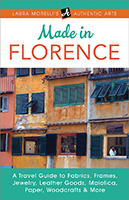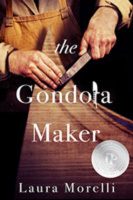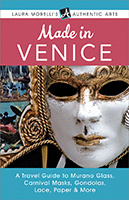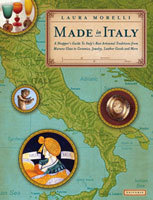As an art historian, naturally I have studied the great Italian artists of the past—Leonardo da Vinci, Michelangelo, Tintoretto, the Lorenzetti, Modigliani, Balla, and others. However, after living in Italy for just a short time, I realized that some of the artistic traditions of the past are still living.
The medieval craft guilds may be long gone, but the techniques, the skill, the forms, the knowledge, the spirit of Italian tradition is still intact in world-class objects like Murano glass, Florentine leather, maiolica ceramics, even Parmigiano-Reggiano cheese and grappa. These traditions are kept alive in the hands of thousands of artisans who take pride in their regional specialties, so ingrained that even in the twenty-first century the products of their labor are recognized around the world as a benchmark of quality.
A Journey from the Alps to the Islands
Once I realized the importance of artisanal tradition within Italian culture, I was riveted; I wanted to know everything! It was the beginning of a journey that would take me from the Alps to Palermo, and become my obsession for more than a decade. I traveled to Sardinia to watch an 88-year-old woman swiftly work a wooden hand loom her grandmother had taught her to use when she was only five. I journeyed to Umbria to watch a ceramicist paint a rabbit on a terra-cotta pot, drawing inspiration from a 500-year-old ceramic fragment at his side. I went to the gastronomic capital of Parma to watch an inspector poke an aging ham hock with a horse-bone needle, and draw it under his nose to rate its quality compared to thousands of similar specimens he has tested over four decades.

Initially, the result of my research was a book called Made in Italy. Over the course of my fieldwork, it was the stories and the people behind these great traditions that captivated me, that kept me moving forward, digging deeper into the roots of Italian culture. The contemporary Italian artisans I interviewed, one after another, told me how important it was to them to pass on the torch of tradition to the next generation.
Art Imitates Life
After hearing that story over and over, I began to wonder what would happen if the successor were not able or willing to take on the duty of passing that torch of tradition. As I interviewed the last remaining gondola makers of Venice, the story of The Gondola Maker, my first work of fiction, germinated inside my head. I wondered about the strict social codes that had once bound boatmakers together in pre-industrial Venice. Their rulebooks governed so many aspects of the guild members’ lives, everything from regulating their apprentices and salaries to dowering their daughters, ministering to their sick, providing for their retired, and burying their dead. Above all, it was expected that a son would follow in his father’s footsteps, and pass the gondola-building secrets to the next generation.
A young man who wished to escape the constraints of this intimate network would face social, financial, and personal obstacles that, in today’s world, we can hardly imagine. The story intrigued me so much that I felt compelled to bring the characters of the gondola maker and his heirs to life in a novel, The Gondola Maker.
What do you think is the role of traditional arts in the world? Drop a comment in the box below!

.fusion-fullwidth-1 {
padding-left: 0px !important;
padding-right: 0px !important;
}
 Join me!
Join me!
Click here to download a free copy of my guide, How to Go Shopping on Vacation Without Getting Ripped Off.
.fusion-button.button-1 .fusion-button-text, .fusion-button.button-1 i {color:#ffffff;}.fusion-button.button-1 {border-width:0px;border-color:#ffffff;}.fusion-button.button-1 .fusion-button-icon-divider{border-color:#ffffff;}.fusion-button.button-1:hover .fusion-button-text, .fusion-button.button-1:hover i,.fusion-button.button-1:focus .fusion-button-text, .fusion-button.button-1:focus i,.fusion-button.button-1:active .fusion-button-text, .fusion-button.button-1:active{color:#000000;}.fusion-button.button-1:hover, .fusion-button.button-1:focus, .fusion-button.button-1:active{border-width:0px;border-color:#000000;}.fusion-button.button-1:hover .fusion-button-icon-divider, .fusion-button.button-1:hover .fusion-button-icon-divider, .fusion-button.button-1:active .fusion-button-icon-divider{border-color:#000000;}.fusion-button.button-1{background: #dd9933;
background-image: -webkit-gradient( linear, left bottom, left top, from( #c97800 ), to( #dd9933 ) );
background-image: -webkit-linear-gradient( bottom, #c97800, #dd9933 );
background-image: -moz-linear-gradient( bottom, #c97800, #dd9933 );
background-image: -o-linear-gradient( bottom, #c97800, #dd9933 );
background-image: linear-gradient( to top, #c97800, #dd9933 );}.fusion-button.button-1:hover,.button-1:focus,.fusion-button.button-1:active{background: #c97800;
background-image: -webkit-gradient( linear, left bottom, left top, from( #dd9933 ), to( #c97800 ) );
background-image: -webkit-linear-gradient( bottom, #dd9933, #c97800 );
background-image: -moz-linear-gradient( bottom, #dd9933, #c97800 );
background-image: -o-linear-gradient( bottom, #dd9933, #c97800 );
background-image: linear-gradient( to top, #dd9933, #c97800 );}.fusion-button.button-1{width:auto;}
GET MY FREE BOOK.fusion-fullwidth-2 {
padding-left: 20px !important;
padding-right: 20px !important;
}Explore my books:



 Learn more about Laura Morelli’s Authentic Arts guidebook series.
Learn more about Laura Morelli’s Authentic Arts guidebook series.
The post Why I Write About Italian Craftsmanship appeared first on Laura Morelli: Art History, Art Historical Fiction, Authentic Travel.
 newest »
newest »
 newest »
newest »
 I can relate to your interest in Italian artisan tradition. While researching my novel "Bridge of Sighs and Dreams" I visited Tarsie Turri, the tarsia lignea (inlaid wood) workshop of Carlo Turri in the village of Anagni. Since one of the main characters in my novel practiced this intricate art form, I wanted information from the foremost workshop of this craft. (Turri's work has been collected by dignitaries world-wide, including Pope Paul and the President of the Republic.) Carla Turri, Carlo's daughter who carries on the tradition, gave me a detailed tour and demonstration of this Renaissance art form. Unfortunately, due to story "flow" I was not able to include in my novel as much information about this art form as I would have liked. However, That personal experience is one I hold dear, and I consider the knowledge I gained to be priceless.
I can relate to your interest in Italian artisan tradition. While researching my novel "Bridge of Sighs and Dreams" I visited Tarsie Turri, the tarsia lignea (inlaid wood) workshop of Carlo Turri in the village of Anagni. Since one of the main characters in my novel practiced this intricate art form, I wanted information from the foremost workshop of this craft. (Turri's work has been collected by dignitaries world-wide, including Pope Paul and the President of the Republic.) Carla Turri, Carlo's daughter who carries on the tradition, gave me a detailed tour and demonstration of this Renaissance art form. Unfortunately, due to story "flow" I was not able to include in my novel as much information about this art form as I would have liked. However, That personal experience is one I hold dear, and I consider the knowledge I gained to be priceless.










